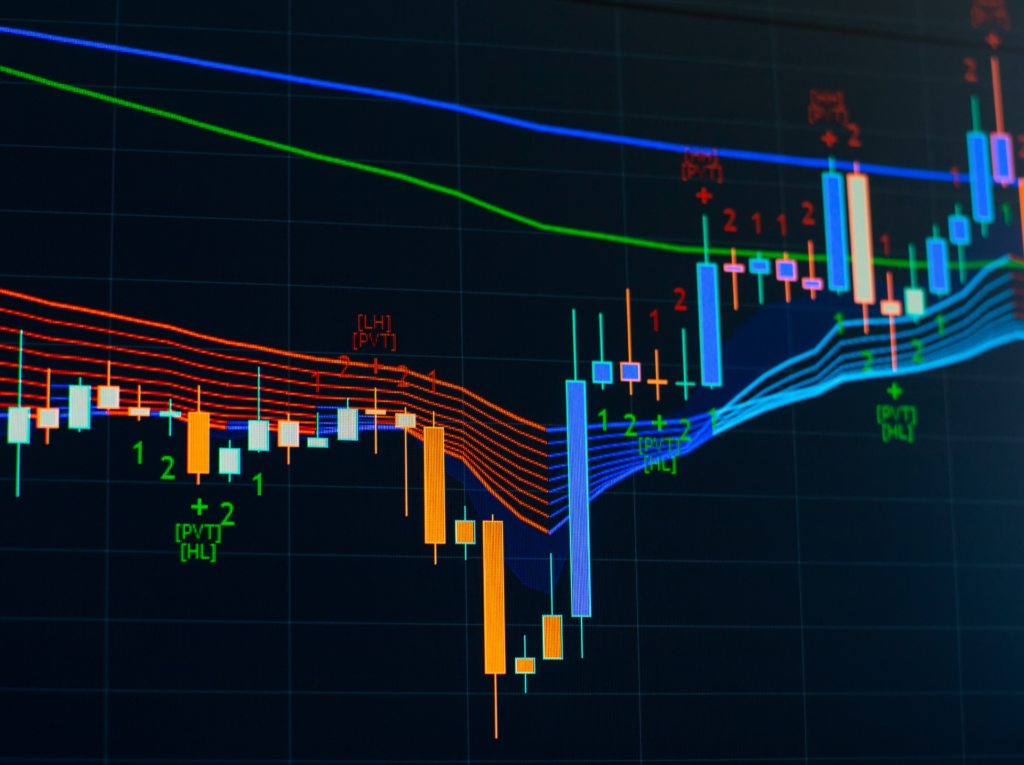Multi-timeframe moving averages (MTF MAs) combine data from different chart timeframes (e.g., daily, weekly, monthly) to give you a broader view of market trends. By aligning signals across timeframes, you can reduce false signals, improve trade timing, and manage risk better. Here’s what you need to know:
- What They Are: MTF MAs use moving averages from multiple timeframes to identify trends and high-probability setups.
- Why Use Them: They cut through market noise, confirm trends across timeframes, and help with precise trade entries and exits.
- Types: Simple Moving Averages (SMA) are stable and better for long-term trends, while Exponential Moving Averages (EMA) are quicker to react and ideal for short-term moves.
- How to Use Them: Start with a higher timeframe to spot the main trend, then use intermediate and lower timeframes to refine setups and entries.
- Key Strategies: Trend alignment, crossovers across timeframes, and using MAs as dynamic support and resistance levels.
For Singapore traders, MTF MAs are especially useful in tracking overnight global activity and navigating SGX trading hours (9:00 AM to 5:00 PM SGT). Focus on widely-used periods like 20, 50, and 200 MAs for better reliability.
MTF MAs aren’t foolproof, but when paired with disciplined risk management, they can help you make smarter trading decisions.
How to Set Up Multi-Timeframe Moving Averages
Setting up multi-timeframe moving averages involves aligning timeframes and periods to match your trading goals. The process starts with choosing the right timeframes based on your trading style and objectives.
Picking the Right Timeframes
Your trading style plays a big role in selecting timeframes. For instance:
- Day traders often focus on shorter intervals like 1-minute, 5-minute, or 15-minute charts.
- Swing traders might prefer hourly, 4-hour, or daily charts to capture medium-term price movements.
- Position traders typically analyse daily, weekly, and monthly charts to identify broader trends.
A common strategy is to use three timeframes: one for assessing the overall trend (high), another for identifying setups (middle), and a third for fine-tuning entry and exit points (low). For example, a swing trader might use daily charts to track the broader trend, 4-hour charts to find setups, and 1-hour charts to time entries.
During periods of high volatility, adjusting your timeframes can help you spot clearer signals. This is especially useful for Singapore traders, as the Singapore Exchange (SGX) operates from 9:00 AM to 5:00 PM SGT. Global market activity outside these hours can impact local stocks, so incorporating daily or weekly charts can help you track larger market trends that shorter timeframes might not capture.
Calculating Moving Average Periods Across Timeframes
To maintain consistency in your analysis, you can adjust moving average periods when switching between timeframes. A straightforward method is to multiply the period by the ratio between the timeframes. For example, if a trading day is divided into six 4-hour periods (as in a 24-hour market), a 20-period moving average on a daily chart would translate to a 120-period moving average on a 4-hour chart.
However, this calculation can vary depending on factors like holidays and trading hours. For Singapore’s markets, the SGX operates on an 8-hour trading day. If you’re adapting moving averages for local stocks, you’d adjust the ratio to reflect this schedule. For example, an 8-hour trading day divided into two 4-hour segments would require recalibrating the conversion accordingly.
In practice, many traders rely on commonly accepted moving average periods that approximate these values rather than making exact calculations.
Finding the Best MA Lengths
After aligning timeframes and periods, the next step is to determine the most suitable moving average (MA) lengths for your strategy. The key is finding a balance between signal frequency and trend reliability:
- Shorter MAs are ideal for capturing quick price movements, making them popular among scalpers.
- Medium-length MAs work well for swing trading, offering a balance between responsiveness and stability.
- Longer MAs help identify major trends and are often used by position traders.
For shorter timeframes, exponential moving averages (EMAs) are often preferred because they react more quickly to recent price changes. On the other hand, simple moving averages (SMAs) provide a smoother, more stable view of the trend, making them better suited for longer timeframes.
Experiment with different combinations to find what works best for your trading approach, but avoid overfitting your strategy to historical data. It’s worth noting that commonly used moving average lengths, such as 50 or 200 periods, often act as key levels because many traders monitor them closely, creating self-fulfilling patterns in the market.
Using Multi-Timeframe Moving Averages in Trading
Now that you’ve set up your moving averages, it’s time to put them into action in real trading scenarios. Multi-timeframe moving averages (MTF MAs) can be a powerful tool when applied with a structured, top-down approach.
Top-Down Analysis for Systematic Trading
A top-down analysis is a key method for making sense of multi-timeframe trading. Start by examining a higher timeframe, such as daily or weekly charts, to determine the overall market trend. For instance, if the 50-period moving average is above the 200-period moving average on the daily chart, this indicates a bullish trend, setting the stage for long trades.
Next, shift to an intermediate timeframe like the 4-hour or hourly chart to pinpoint setups that align with the primary trend. In a bullish market, look for pullbacks toward moving averages on this timeframe, as they often act as dynamic support zones.
Finally, drill down to a lower timeframe, such as the 15-minute or 5-minute chart, to refine your entry. Watch for price action that confirms a bounce off the support identified on the intermediate chart. Once confirmed, you can time your trade with precision.
For traders in Singapore, keep in mind that SGX operates from 9:00 AM to 5:00 PM SGT. Analysing higher timeframes is particularly important as it captures overnight developments that could influence SGX-listed stocks – details that shorter timeframes might overlook.
With this structure in place, you can enhance your strategy by incorporating price action.
Combining MTF MAs with Price Action
Pairing MTF MAs with price action helps you achieve better timing for entries and exits. The moving averages act as a roadmap, while price patterns provide the signals for action.
When moving averages align across multiple timeframes, they highlight key support or resistance zones. For example, if the 50-period MA on the daily chart lines up with the 200-period MA on the 4-hour chart, this overlap could signify a high-probability area for price reversals or continuations.
Pay attention to price rejection at these levels. A candlestick with a long tail that closes above a moving average, especially after a pullback in an uptrend, often signals the continuation of the trend.
Volume adds another layer of confidence. A price bounce at a confluence zone accompanied by high trading volume suggests strong market conviction. This is particularly useful for SGX-listed stocks, where volume often reflects the activity of institutional players and their timing strategies.
The interplay between price and moving averages across timeframes also sheds light on market sentiment. Prices consistently trading above rising moving averages indicate strong bullish momentum, while repeated failures to recover these levels may hint at underlying weakness.
Once you’ve developed your entry strategy, it’s essential to pair it with solid risk management practices.
Risk Management Tips
Risk management is the backbone of successful trading, especially when using multi-timeframe analysis. While a broader market view can boost confidence, it can also lead to overestimating the reliability of setups.
Your position size should align with both your risk tolerance and the timeframe you’re trading. For example, if you’re risking S$500 on a trade with a 100-point stop-loss, adjust your position size accordingly – keeping in mind that SGX trades only in whole shares.
Stop-loss placement is another area where multi-timeframe insights can help. Instead of relying solely on short-term price moves, consider placing your stop-loss just below a significant moving average on the daily chart. This approach reduces the likelihood of being stopped out by minor fluctuations while still protecting you from a true trend reversal.
Scaling out of positions is another effective strategy. You can take partial profits when the price hits a resistance level on an intermediate timeframe, while leaving the rest of your position open to capture potential gains suggested by the higher timeframe trend. This allows you to lock in profits while staying in the game for bigger moves.
Be cautious of sector correlations when managing multiple SGX positions. If several trades are influenced by similar multi-timeframe signals, their combined movement could increase your overall exposure to risk.
Finally, consider time-based exits. If your higher timeframe analysis suggests that a trade should unfold within a specific period but the price remains stagnant, it may indicate a flawed setup – even if your stop-loss hasn’t been triggered.
Common Strategies Using Multi-Timeframe Moving Averages
Multi-timeframe moving averages (MTF MAs) offer traders a well-rounded perspective by combining insights from different timeframes. This approach allows for more informed and precise trading strategies.
Trend Alignment Strategy
One popular method involves aligning trades with the dominant trend, which can significantly improve success rates by steering clear of trades that go against the market’s main direction.
Start by confirming the primary trend on the highest timeframe. For instance, if the daily chart shows an uptrend with shorter moving averages stacked above longer ones, this signals bullish momentum. Once the dominant trend is clear, shift to an intermediate timeframe, such as the 4-hour chart, to pinpoint trade setups. In this case, look for price pullbacks to key moving averages, as they often signal temporary dips in a strong trend.
Finally, refine your entry on the lowest timeframe, such as the 1-hour chart. Watch for patterns like bullish engulfing candles or hammer formations near moving averages. This layered approach ensures your trades align with the broader trend while giving you precise entry points.
For traders focusing on SGX stocks, this strategy can be particularly effective during earnings seasons when trends in individual stocks often persist for weeks.
Using Crossovers Across Timeframes
Moving average crossovers gain reliability when observed across multiple timeframes. Instead of acting on every crossover, focus on those that align across different time horizons.
For example, a golden cross – where a shorter moving average crosses above a longer one – occurring on both daily and 4-hour charts within a short period signals a strong momentum shift. Crossovers that first appear on higher timeframes and are later confirmed on lower timeframes often indicate the start of a sustained move, while those limited to lower timeframes are more prone to false signals.
For SGX traders, crossovers during periods of higher trading volume are particularly noteworthy. Increased volume often reflects institutional activity, which can drive price movements over extended periods. To avoid redundancy, consider using different moving average pairs on different timeframes. For example, monitor 20/50 period crossovers on a 4-hour chart and 50/200 crossovers on a daily chart. This combination provides complementary, rather than overlapping, signals.
These confirmed crossovers also set the stage for using moving averages as dynamic support and resistance levels.
Support and Resistance with MTF MAs
Moving averages act as dynamic support and resistance levels, adjusting with price movements. These levels offer more relevant reference points than static horizontal lines, especially when analysed across timeframes.
The most important levels often emerge where moving averages from different timeframes converge. For instance, if the 200-period moving average on a daily chart aligns closely with the 50-period moving average on a weekly chart, this creates a highly significant zone. Price reactions at such levels are typically more reliable and pronounced.
In trending markets, moving averages serve as stepping stones. For example, in an uptrend, price may find support at the 20-period moving average on lower timeframes, the 50-period moving average on intermediate timeframes, and the 200-period moving average on higher timeframes. Each successful test of these levels strengthens their importance.
The timeframe also matters when assessing the strength of these levels. A rejection at a daily moving average carries more weight than one at a 15-minute moving average. This hierarchy helps prioritise which levels to focus on during analysis.
For SGX traders, it’s essential to consider how institutional trading hours (9:00 AM to 5:00 PM SGT) influence these levels. Moving averages tend to hold more significance during active trading hours, while overnight gaps can sometimes cause price to bypass these levels. Understanding this timing can help you set realistic expectations for how price interacts with your identified zones.
Additionally, the slope of a moving average plays a role in its effectiveness. In trending markets, steeply angled moving averages provide stronger support or resistance compared to flat or gently sloping ones, which are more common in sideways markets. This detail can further refine your analysis and decision-making.
Master Systematic Trading with Collin Seow
Learn proven trading strategies, improve your market timing, and achieve financial success with our expert-led courses and resources.
Best Practices and Common Mistakes
Mastering multi-timeframe moving averages requires discipline. When done right, it can sharpen your analysis and help you avoid unnecessary losses.
Best Practices for Multi-Timeframe Analysis
Start with the highest timeframe. This “top-down” method ensures you focus on the bigger picture before diving into smaller, more volatile movements. For example, use weekly or daily charts to spot the dominant trend, then zoom into shorter timeframes, like 4-hour or hourly charts, to fine-tune your entry points. Remember, signals from higher timeframes carry more weight than those from lower ones, especially when they conflict.
Stick to consistent moving average settings. If you use 20, 50, and 200-period moving averages on your daily chart, apply the same settings on your 4-hour and 1-hour charts. This consistency helps you interpret signals more effectively and avoids confusion caused by mismatched settings.
Keep a trading journal. Document which timeframe combinations work best for your style and the markets you trade. For instance, daily and 4-hour charts might work well for SGX blue-chip stocks, while more active traders may prefer hourly and 15-minute charts for short-term opportunities.
Look for confluence. The most reliable signals come when trends, moving averages, and price action align across multiple timeframes. Avoid acting on a single timeframe signal, no matter how strong it looks. Instead, wait for confirmation across at least two timeframes to improve your odds of success.
These practices align with broader risk management principles and help create a structured approach to trading.
Common Mistakes to Avoid
Over-tweaking moving average settings. Constantly adjusting parameters to fit past data can lead to overfitting, which rarely works in live markets. Instead, use widely-recognised periods like 20, 50, and 200. These are popular for a reason – they reflect the behaviour of a broad range of market participants.
Ignoring the market’s context. Moving averages behave differently in trending versus range-bound markets. In strong trends, shorter moving averages often act as reliable support or resistance. However, in sideways markets, they can generate false signals. Always evaluate the broader market conditions before applying your analysis.
Mixing moving average types haphazardly. Combining simple and exponential moving averages without understanding their differences can lead to conflicting signals. Since each type reacts differently to price changes, mixing them requires careful consideration to maintain analytical reliability.
Expecting moving averages to work in all conditions. These indicators perform best in trending markets but often fail during periods of extreme volatility or major news events. For instance, earnings announcements or geopolitical developments can cause prices to gap through moving averages, rendering them ineffective.
Tailor these practices to suit the unique dynamics of Singapore’s trading environment.
Trading in Singapore’s Market Environment
When applying these strategies to the SGX, consider the nuances of the local market. For instance, SGX trading hours (9:00 AM to 5:00 PM SGT) often create price gaps at market open, temporarily distorting moving average levels.
Liquidity matters. Blue-chip stocks on the SGX typically respect moving averages more consistently due to higher trading volumes and institutional activity. On the other hand, smaller-cap stocks can behave more erratically around these levels, requiring wider stop-losses and more conservative position sizing.
Currency considerations. When trading SGX stocks, prices are in Singapore dollars, simplifying calculations. However, if you also trade international markets, factor in currency conversion risks when managing your portfolio.
Regulatory stability. Singapore’s well-regulated trading environment, overseen by the Monetary Authority of Singapore, supports systematic trading strategies. Unlike markets with frequent rule changes, SGX allows for consistent strategy implementation, making multi-timeframe analysis particularly effective.
Seasonal factors, such as the Chinese New Year, can also influence trading patterns. Extended holidays may reduce market activity, affecting moving average reliability during these periods.
Finally, the strong institutional presence on the SGX amplifies the importance of widely-followed moving averages like the 50-day and 200-day. These levels often act as key support and resistance zones, as institutional traders tend to make decisions based on them, turning them into self-fulfilling prophecies.
Conclusion
Using multi-timeframe moving averages gives you a clearer picture of market sentiment and trend strength. Start with higher timeframes to identify the broader trend, then work your way down to refine your entry and exit points.
To get the most out of this strategy, stick to commonly used moving average periods like 20, 50, and 200. These are widely followed by institutional traders, especially when analysing blue-chip stocks on the SGX, making them reliable benchmarks.
It’s important to remember that no single indicator can guarantee profitable trades. While multi-timeframe moving averages help cut through market noise and highlight potential setups, they require patience and discipline to execute effectively. Set realistic goals and always prioritise protecting your capital.
For traders in Singapore, the SGX offers a stable regulatory environment and a strong institutional presence, which enhances the effectiveness of multi-timeframe analysis. The market’s structured trading hours also make it easier to implement systematic strategies.
The key to success lies in consistency. Avoid chasing every market move, focus on aligning signals across timeframes, and maintain disciplined risk management to navigate varying market conditions.
By mastering multi-timeframe analysis, you can gain deeper insights into market behaviour and improve your trade timing.
To take your skills further, explore the educational tools and resources available at Collin Seow Trading Academy (https://collinseow.com).
FAQs
How can I select the best timeframes for multi-timeframe moving averages based on my trading style?
To pick the best timeframes for multi-timeframe moving averages, start by matching them to your trading style and objectives. For instance, use higher timeframes like daily or 4-hour charts to get a sense of the broader trend. Then, combine them with lower timeframes such as 1-hour or 15-minute charts to fine-tune your entry and exit points.
If you’re into swing trading, working with 2-3 timeframes often works well. On the other hand, day traders might lean towards shorter timeframes to balance analysing trends with making quicker decisions. A handy rule of thumb is to keep a ratio of about 1:4 or 1:6 between your higher and lower timeframes. This helps maintain clarity while giving you a good mix of long-term and short-term perspectives.
What advantages do multi-timeframe moving averages offer for SGX traders?
Multi-Timeframe Moving Averages: A Broader Market Perspective
Using multi-timeframe moving averages offers SGX traders a deeper insight into market trends by examining price movements across various timeframes. This method allows traders to confirm trends with greater accuracy, enabling them to fine-tune the timing and execution of their trades.
By aligning short-term trading strategies with the prevailing longer-term trends, traders can pinpoint trade opportunities with higher potential. It also helps validate the market’s direction, reducing guesswork. On top of that, this approach enhances risk management, equipping traders with the confidence to make well-informed decisions in Singapore’s trading landscape.
How do I use multi-timeframe moving averages with price action to refine my trading strategy?
To sharpen your trading strategy with multi-timeframe moving averages and price action, start by checking if the moving averages across various timeframes are pointing in the same trend direction. This alignment acts as a strong indicator of the market’s overall direction.
Then, keep an eye out for price action signals like candlestick patterns – think pin bars or engulfing candles – or breakouts that reinforce the trend shown by the moving averages. Combining these tools can help you fine-tune your trade entries, minimise the chances of falling for false signals, and trade with greater confidence and consistency.












